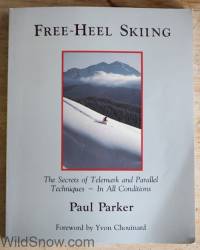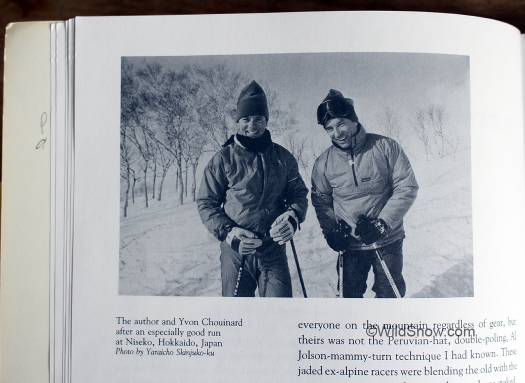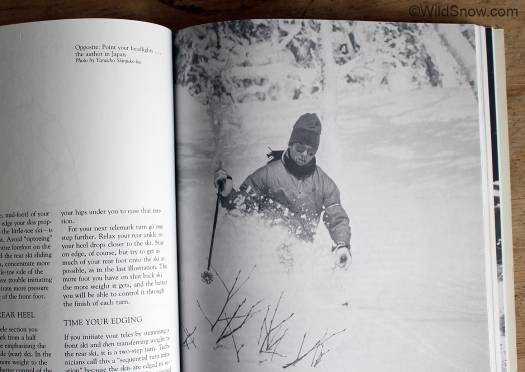Editor’s Note: Last week’s post about skiing close to home got quite a bit of commentary, some around chasing Japan pow. The feedback sent me into a wormhole of ski tourism in Japan. The result: on one end of the wormhole, this 2018 article in Bloomburg Business Week, stating that Hokkaido is poised to take over as the world’s premier ski hub.
On the other end: the dark corners of the WildSnow archives where I uncovered this gem recounting the origin of “Japow” pilgrimages. As a ski tourer who was born around the time Paul Parker and Yvon Chouinard were embarking on early pilgrimages, their influence on the current hype around Japan powder was news to me. Here, Lou gets the inside scoop from Parker. Valuable insights into the legacy and evolution of the sport, and also, it’s a damn good story.
Paul Parker, Yvon Chouinard and the early days of Japan powder skiing
If you ski tour, Paul Parker has changed your life. One of the most influential and long-term product developers in the outdoor recreation industry, Paul has worked on everything from the first plastic telemark boots all the way up to Garmont and on to Scott. He’s also a writer, and of course a dedicated skier.
Back in 1980s, days of ancient past, back before Chouinard Equipment morphed into Black Diamond, Paul and Yvon Chouinard went skiing in Japan. Beautiful artistic photos of skiing Japanese “Japow” powder were subsequently published in various print media.
Paul would never claim any credit for starting things, but in my view perhaps his and Yvon’s early skiing over there is the foundation of the current frenzy.
Japan skiing in a modern recreational sense has been going since the 1920s, yet Hokkaido and other such areas have much more recently gained the reputation as world-class powder heavens.
But when did the Japanese “powder pilgrimages” actually begin? In my case, the first time I learned about the place was seeing photos in a Chouinard Equipment catalog. It looked wonderful, but too expensive and exotic for 1980s budget ski travel. Yet that’s probably when the buildup began for what “Japow” is now. I recently asked Paul if perhaps he and Yvon “discovered Hokkaido” for powder skiers. Here is his answer.
Paul Parker: “I marvel at how people are now talking about skiing Japan, like it’s something new. I guess that could be because it’s not so easy to get around in Japan, and traveling over there has not been widely popular until recently. You drive on the other side of the road; in any areas but the big cities, road signs are in characters; there has not been much English until recent years; etc. It’s certainly good skiing and a wonderful culture. But it is not new.
The first time Yvon and I went was probably 1984. We went with several Japanese friends: Naoe Sakashita, then distributor for Chouinard Equipment Japan, now BD Japan, and known as “Lucky Boy” for his Himalayan climbing accomplishments. Naoe is a remarkable athlete who in 1984 had not skied much at all. He took alpine skis, got his ass kicked and bounced right back up for more. Amazing. Isuzu Tatsuno, owner of Montbell, who was then the Japanese distributor for Patagonia, an experienced climber as well who had climbed the North Face of the Eiger, and Mr. Kenai, owner of one of the nicest shops in Sapporo.

Paul Parker’s ‘Free Heel Skiing’ book, published in 1988, had quite a few photos from powder skiing in Japan.
It’s hard for me to remember exactly how the idea was cooked up. As I remember Yvon was curious about skiing there, had been talking to Tatsuno about it. I was curious about skiing there and was lucky enough to be included. Yvon (as I do) has great respect for the Japanese culture which was an important motivator. I don’t recall having heard about it from anybody except those guys: Naoe, Tatsuno, and Yvon.
Mr. Kenai’s father, a very distinguished elderly Japanese gentleman, not a word of English and traditional dress, drove us around in his left-hand drive Mercedes that I think Kenai said he’d bought from the Korean embassy. He would leave us at a ski area and go hang out at an onsen and come back a couple of days later and take us somewhere else.
We based out of the Woodpecker Lodge, still there, owned by good friend Shinya-San and his wife Norieko, at a small satellite ski area near Niseko. We skied quite a bit with members of the “Japanese Telemark Association” — small in numbers but enthusiastic. As I remember Mr. Yamamoto was one of those skiers and we stayed at his lodge in Niseko.
Yvon and I went back to Japan a couple of times, visiting Hokkaido again as well as Nagano, which was very interesting for a variety of reasons. I also went back on a Garmont trip in the 90s and experienced one of the most epic storms that I’ve seen at Yamagata Zao on the main island. I had what were then very fat skis (prototype Tua Sumo), while most everyone else was stacked up on some kind of racing ski as that’s what people skied in those days. It was a total blast, about a meter a day for four days.
The first edition of “Free-Heel Skiing” has a bunch of pictures from that first trip to Hokkaido. We had a photographer (Yaraicho Skinjuko-ku) who traveled with us and chronicled the adventure, in part because there simply were not many gaijin who skied there and we had a bit of notoriety in various camps, and a bunch of journalists wanted to write about it.
In those days, Japanese were very hungry for American skiing culture. There were several articles in various mountain magazines, one called Outdoor which I probably have buried somewhere. I guess it was a bit of a ground-breaking trip to see Americans over there, particularly on telemark skis.
I have many nice memories of skiing in Japan. It’s fun to think about it again — a lucky boy to be hanging out with those guys; a wonderful opportunity at many levels.
WildSnow.com publisher emeritus and founder Lou (Louis Dawson) has a 50+ years career in climbing, backcountry skiing and ski mountaineering. He was the first person in history to ski down all 54 Colorado 14,000-foot peaks, has authored numerous books about about backcountry skiing, and has skied from the summit of Denali in Alaska, North America’s highest mountain.


